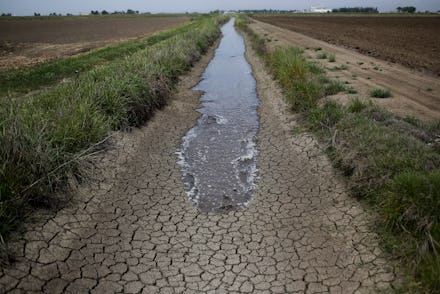UC Davis Study Reveals the Astronomical Costs of California's Drought

The news: California is currently going through one of the worst droughts in its recorded history. The severe water shortage turned deadly last week, as wildfires ravaged 30 square miles of the dry, hot landscape.
And now a new study from the University of California, Davis has revealed the true economic costs of this devastating phenomenon. Conducted at the request of state authorities, the study estimates that California's Central Valley breadbasket stands to lose $1.7 billion from the drought. It also predicts that 410,000 acres — 6% of the Central Valley's irrigated cropland — will be fallow this growing season, potentially costing 14,500 full-time and seasonal jobs.
"These estimates will help the state better understand the economic impacts of the drought and target its drought relief," Karen Ross, California's food and agriculture secretary, said in a press release. "The research confirms where emergency drought assistance will be needed most, and efforts are already underway."
Image Credit: Getty
What this means: For now, California is combating its severe water shortage by pumping groundwater supplies. While the operation is expensive — upwards of $450 million — it is preventing the situation from spiraling further out of control. "Without access to groundwater, this year's drought would be truly devastating to farms and cities throughout California," said Jay Lund, the study's co-author.
And it's important to note that while the drought has huge consequences for California's agricultural sector, the industry only accounts for 3% of the state's $1.9 trillion GDP — which means that the economic impact will be localized, and won't really affect the overall state economy. State GDP is expected to fall by $855 million due to the drought, and household income may drop by $555 million.
"Local communities will be hit the worst," Lund told Mashable. "We'll see higher unemployment, more welfare expenses and less tax revenue coming in."
But there are financial implications for the rest of the country as well. California currently produces nearly half of all fruits, nuts and vegetables, and is also a major producer of beef and dairy products. As America's biggest agricultural region, California — along with Mexico and West Africa, which are experiencing similar weather conditions — can put a lot of pressure on national and global food prices.
How this relates to climate change: Last week marked the first time in a century that the U.S. Drought Monitor declared all of California to be under a "severe" drought; some areas received "extreme" to "exceptional" labels (colored red and maroon above).
And California Governor Jerry Brown is blaming the ongoing trouble on climate change and blasting those who doubt the impact of global warming. "We're going to deal with nature as best we can, but humanity is on a collision course with nature and we’re just going to have to adapt to it in the best way we can," Brown said on ABC's This Week. "There is no scientific question — there's just political denial for various reasons, best known to those people who are in denial."
In the past three months, three different studies have linked climate change to increasing temperatures, droughts and insect outbreaks — as well as wildfires, which have been starting earlier and earlier in the year. And now we can already see the economic toll on America's biggest and most valuable farmland. Hopefully that will finally be enough to make people realize something must be done before it's too late.